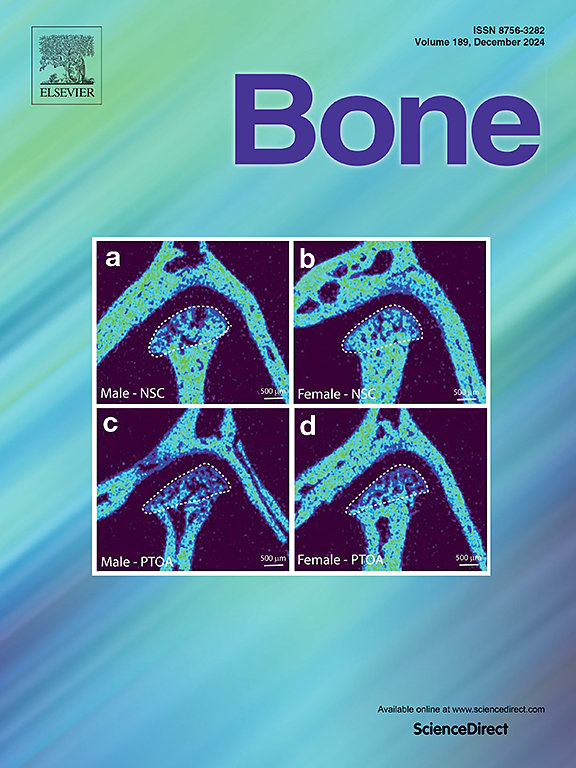甘油三酯-葡萄糖累积暴露指数与脆性骨折发病风险的关系。
IF 3.5
2区 医学
Q2 ENDOCRINOLOGY & METABOLISM
引用次数: 0
摘要
目的:探讨普通人群甘油三酯-葡萄糖指数(cumTyG指数)与脆性骨折的关系。方法:采用前瞻性队列研究方法,对2006年、2008年和2010年连续三次参加健康检查的开滦集团在职和退休员工进行随访,随访至2022年12月31日。该队列包括55,824名符合纳入和排除标准的参与者,并使用cumTyG指数四分位数进行分组。结局事件为发病脆性骨折。采用Kaplan-Meier法计算各组脆性骨折的累计发生率,并绘制发生率曲线。采用log-rank检验进行组间比较。采用Cox回归模型分析脆性骨折的风险比(HR)和95% %置信区间(CI)。结果:在平均11.35 年的随访期间发生了900例脆性骨折。经多因素Cox回归分析和混杂因素校正(全模型),cumTyG指数最高组与cumTyG指数最低组的HR(95 % CI)为1.30(1.04-1.61)。脆性骨折的风险在男性(HR 1.37, 95 % CI 1.06-1.77)和服用抗高血压药物的患者(HR 2.47, 95 % CI 1.25-4.86)中较高。cumTyG指数与脆性骨折风险呈线性相关。结论:高cumTyG指数是脆性骨折的危险因素,在高血糖、高胆固醇患者的治疗中应予以考虑。本文章由计算机程序翻译,如有差异,请以英文原文为准。
The cumulative exposure to triglyceride-glucose index and the risk of onset fragility fractures
Objective
To investigate the association between the cumulative exposure to triglyceride-glucose index (cumTyG index) and fragility fractures in the general population.
Methods
This prospective cohort study analyzed active and retired employees of Kailuan Group who participated in three consecutive health examinations in 2006, 2008 and 2010, and were followed up until 31st December 2022. The cohort comprised 55,824 participants who met the inclusion and exclusion criteria and were grouped using the cumTyG index quartiles. The outcome event was onset fragility fracture. The cumulative incidence of fragility fracture in each group was calculated by the Kaplan–Meier method, and the incidence curve was plotted. Between-group comparisons were performed using the log-rank test. A Cox regression model was used to analyze the hazard ratio (HR) and 95 % confidence interval (CI) of fragility fractures.
Results
Nine-hundred fragility fractures occurred during a mean follow-up of 11.35 years. After multivariate Cox regression analysis and adjustment for confounders (full model), the HR (95 % CI) of the group with the highest cumTyG index compared with the group with the lowest cumTyG index was 1.30 (1.04–1.61). The risk of fragility fracture was higher in men (HR 1.37, 95 % CI 1.06–1.77) and those taking antihypertensive drugs (HR 2.47, 95 % CI 1.25–4.86). There was a linear association between the cumTyG index and the risk of fragility fracture.
Conclusion
A high cumTyG index is a risk factor for fragility fracture and should be considered in the management of patients with high blood sugar and high cholesterol concentrations.
求助全文
通过发布文献求助,成功后即可免费获取论文全文。
去求助
来源期刊

Bone
医学-内分泌学与代谢
CiteScore
8.90
自引率
4.90%
发文量
264
审稿时长
30 days
期刊介绍:
BONE is an interdisciplinary forum for the rapid publication of original articles and reviews on basic, translational, and clinical aspects of bone and mineral metabolism. The Journal also encourages submissions related to interactions of bone with other organ systems, including cartilage, endocrine, muscle, fat, neural, vascular, gastrointestinal, hematopoietic, and immune systems. Particular attention is placed on the application of experimental studies to clinical practice.
 求助内容:
求助内容: 应助结果提醒方式:
应助结果提醒方式:


